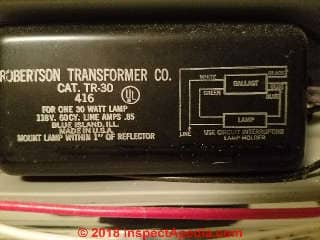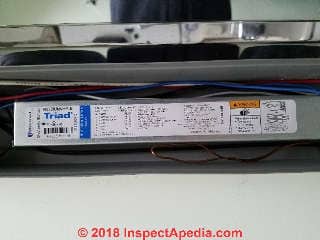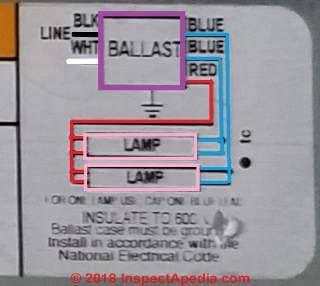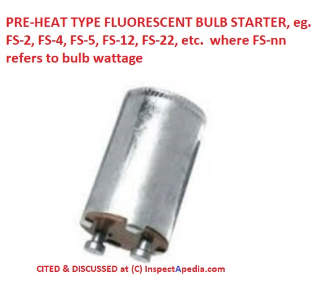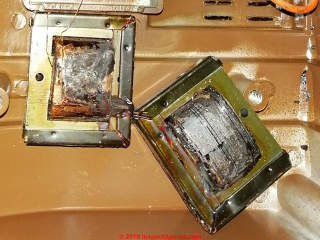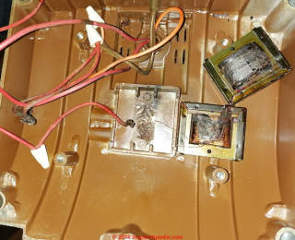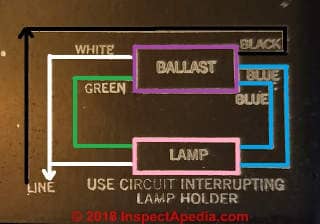 Fluorescent Light Ballast Repair
Fluorescent Light Ballast Repair
Replacement transformer wiring connections
- POST a QUESTION or COMMENT about building electrical systems, power, wiring, and flickering or dimming lights
Steps in replacing the ballast or transformer to cure a dead or a flickering fluorescent light.
This article series explains how to diagnose and repair fluorescent lights in buildings.
Watch out: flickering or dimming lights might indicate a dangerous condition risking a building fire or an electrical shock. If the simple bulb or starter repairs we describe here don't cure the flickering, switch off the bad-acting light fixture, leave it off, and ask for help from a licensed electrician.
InspectAPedia tolerates no conflicts of interest. We have no relationship with advertisers, products, or services discussed at this website.
- Daniel Friedman, Publisher/Editor/Author - See WHO ARE WE?
Replacing & Wiring a Fluorescent Light Ballast or Transformer
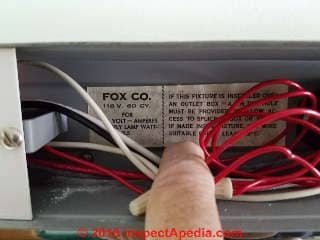 In the photo I am showing the original data tag for this Fox Co. fluorescent fixture installed in the bathroom of a Minnesota home built in 1963.
In the photo I am showing the original data tag for this Fox Co. fluorescent fixture installed in the bathroom of a Minnesota home built in 1963.
[Click to enlarge any image]
To stop the flickering light in this luminaire fixture I needed to replace the ballast.
Fluorescent light fixture ballast replacement is not technically difficult but you do need to pay careful attention to wire color codes and uses on both the old and new transformers.
Watch out: You could be shocked or killed. Turn off electrical power before touching or attempting to work on electrical lights or fixtures.
Watch out: if you are not trained and comfortable with proper electrical wiring and repair work, hire someone who is qualified. Making a mistake can cause a building fire, shock, injury, or death.
Watch out: after electrical power has been removed from the light circuit you must also ground the ballast terminals before touching any wire ends; a ballast can give a tremendous electrical shock.
In concept replacing a fluorescent lamp ballast or transformer is pretty simple; what can be intimidating is the plethora of wiring diagrams on the new ballast, none of which matches exactly the wiring diagram on the original unit.
Ballast manufacturers like Phillips offer technical support, including a telephone number to call for assistance.
Let's sort this out.
Line voltage (typically 120VAC) is supplied to the ballast or transformer.
High voltage output from the transformer connects to the two clip terminals on one end of the fluorescent light bulb.
The other end of the fluorescent light bulb (the two terminals on the clips there) connect to the neutral side of the ballast or transformer and through it back to the circuit neutral.
When we understand those rules we can make sense of otherwise confusing differences among fluorescent lamp transformer wiring diagram differences between the original 50-year old transformer and the new replacement transformer.
Two Approaches to light ballast replacement
Watch out: before dis-assembling or removing any lamp parts, label every wire and connection point - and take a few photos too. That can save some embarrassment at re-assembly time.
- Find an exact OEM replacement for the original ballast
You can try to find the exact replacement or a generic replacement light ballast that is asserted to support or replace the original that has failed. There are many such ballast products available from electrical suppliers, hardware stores, building suppliers, and online vendors.
Some of these replacement ballasts are generic and can support a range of original units besides your particular one.
You may be able to follow the wiring diagram on your original ballast by identifying the equivalent wires on the new ballast, using just those and capping off any other wires that are not used. - Find a ballast that supports the bulbs and wattages and follow the wiring diagram
This is what I had to do for this light fixture because an exact OEM replacement transformer was not available.
You can make note of the wattage of fluorescent bulbs in your light fixture and the number of them, and then purchase a replacement ballast sold to support those. You will need to follow the wiring instructions for the new ballast.
Printing or labels as well as an examination of the wires and connections on all fluorescent light ballasts will provide the following information:
- Bulb wattage supported
- Number of bulbs supported
- Manufacturer and part number
- Voltage supported
- A wiring diagram printed right on the ballast surface
- Physical wires: look at the number of wires and to what they are connected in the current light fixture. Take photos, make a drawing - do not fail to record this information as it makes wiring a new ballast far easier.
Match Replacement Ballast Wiring to Original Ballast Wiring
Below is the old Robertson Transformer Co. ballast from 1963. Note the ballast provides all of the information needed to replace it.
- Ballast catalog no.: CAT. TR-30 416
- Lamps: One 30-Watt lamp
- Power: 118V 60 Cy Line amps 0.85
- Wiring diagram details
The ballast may also tell you the bulb type supported: this bathroom vanity light used 30-W T8 type bulbs.
The light fixture carried two 30-watt fluorescent bulbs, each supported by an individual ballast. However currently it's possible to buy a single ballast that can support two 30-watt bulbs - as another option.
Watch out: if you are not trained and comfortable in safe proper electrical wiring procedures do not try to replace the transformer or ballast or other electrical light fixture internal parts yourself. A mistake could result in a fire, or you could be shocked or killed.
The original light fixture used two separate Robertson Transformers, or ballasts, one for each 30-watt lamp.
The replacement ballast, from Triad, was smaller, lighter, (and maybe less durable?) and specified that it could support two 30-watt lamps, simplifying the wiring and replacement job.
[Click to enlarge any image]
Watch out: take care to read the wiring diagram on the original ballast and on the replacement ballast to make proper electrical connections.
Some replacement ballasts are designed to handle multiple situations, so you may find that you do not need to use all of the wires on the new ballast. Be sure to use twist-on connectors to cap off any un-used wire ends.
Below: the wiring diagram on the original light fixture ballast or transformer:
Watch out: you'll notice that the line voltage (hot - black and neutral - white) 120V wires on the original ballast connect to opposite ends of the ballast: white at one end and black at the other.
Pay close attention to the wiring diagrams and the wire colors. Don't just assume that wires at a particular end of the new ballast have the same functions as on the old ballast. In this case they do not.
Notice also that the "green" wire in the original transformer diagram is NOT a ground wire.
Wires On the Original Ballast / Transformer
- Black - line hot - wire is at the right end of the transformer where a pair of blue wires emerge.
- White - line neutral - wire is at the left end of the transformer and is going to connect to one terminal of the fluorescent lamp connector.
- Green - (NOT a ground wire) in this case is connecting the ballast to the second terminal on the same fluorescent lamp connector as received the white or neutral wire.
- Blue-1: two blue wires are going to take power to one end of the fluorescent T8 30W lamp circuit or holder. One of these connects to one of the terminals on the opposite end of the bulb from that receiving the green and white wires
- Blue-2: the second blue wire connected to the other terminal on the same bulb connector as Blue 1.
Wires on the Replacement Ballast / Transformer
Take careful note of the wiring diagram on the new ballast as it will tell you which color coded wires make which connections in the light fixture.
The replacement ballast provides 5 wires: black, white, blue, blue (equivalent) and red.
Incoming electrical power at the fixture connects to the line BLACK and WHITE wires shown on the diagram.
If we are using the new ballast to support just one 30W T8 bulb we'd use the red wire connecting to the terminals on one end of the lamp holder/socket and one of the blue wires for the other end of the lamp holder/socket.
If we're wiring two 30W lamps we'd use the second blue wire to take power to that lamp;
The red wire is used in common on both lamps.
I wired the new ballast as shown in the diagram above, following the wire color codes. The light worked perfectly.
See
- Osram Sylvania, FLUORESCENT LIGHT BALLAST TECHNOLOGY [PDF], retrieved 2018/09/17, original source: https://www.sylvania.com/en-us/innovation/education/light-and-color/Pages/ballasts-technology.aspx
- Universal Lighting Technologies, BALLAST NAVIGATOR CATALOG [PDF] provides a guide to selecting ballasts for all types of fluorescent light fixtures, Universal Lighting Technologies, TEl: 1-800-BALLAST, Website: https://unvlt.com/literature/ballast-navigator/ produces electronic ballasts for fluorescent light fixtures. Universal produces the Triad® brand of lamp ballasts.
Or read more about fluorescent light fixture ballasts or transformers at our recommended Continue Reading link immediately below.
...
Reader Comments, Questions & Answers About The Article Above
Below you will find questions and answers previously posted on this page at its page bottom reader comment box.
Reader Q&A - also see RECOMMENDED ARTICLES & FAQs
On 2020-07-12 - by (mod) - match fluorescent bulb ballast to lamp size?
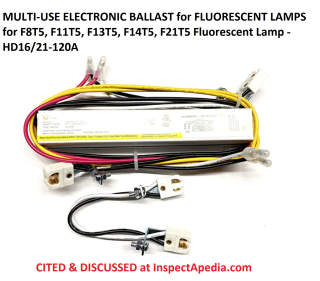 Eric
Eric
Thank you for a helpful question that I'd put as: how closely do I need to match the ballast to bulb types on my fluorescent lights?
Ballasts are "tuned" to start fluorescent bulbs of a particular length. But having replaced a sickening number of fluorescent lamps and ballasts and starters and finding that the exact original replacement is often hard to find, I note that happily there are modern replacement ballast products that very often are rated for a wider range of fluorescent bulbs than their ancestors.
For example, the "Electronic Ballast for F8T5, F11T5, F13T5, F14T5, F21T5 Fluorescent Lamp - HD16/21-120A" - shown below and for sale at Amazon, is marked for both F13T5s AND F14T5s and will work just fine for both.
So let's do this: take a close look at the label on your new ballast. If it indicates it's intended for both F13s and F14s you're fine.
If it's not, it may work OK but you may see poor start-up performance.
On a multi-use or multi-lamp-rated ballast you'll find boht a wiring diagram and often extra wires that you might or might not need to use, dependingon the original fluorescent lamps and fixture being repaired. Just use twist-on connectors to cap off any un-used leads.
Watch out: when you see a delay in turning on fluorescent lamps or bulbs, be sure to check for:
- old fluorescent bulbs that need to be replaced: this may be true even if you don't see that characteristic black or "burned" area near the ends of the bulb
- old, corroded, or loose electrical connectors or connector-to-wire connections in the fluorescent light fixture itself
- a bad starter
So if your lights use them (used on pre-heat type fluorescent lamps or bulbs), also take a look at your starter(s); you'll find a range of them:
FS-2, FS-4, FS-5, FS-12, FS-22, etc. (they're very inexpensive -less than a dollar)
The FS- number refers to the bulb wattage.
but
Watch out: some of the new starters I've bought, made in China, were incredibly flimsy, poorly made, in fact so poorly made that the starter fell apart simply with the push and twist torque necessary to insert and lock the fluorescent lamp starter into its socket.
I should have added that even if the ballast appears to work with the "wrong" bulb, an effect may be a reduced bulb life.
On 2020-07-12 by Eric
I recently had to replace a ballast on one of my under cabinet lights in my kitchen. The old ballast was rated for 2 F13T5 bulbs 21”. The new ballast is rated for 2 F14T5 bulbs 21”. Is it okay to use the 2 F13T5 bulbs? The only difference I see this far is when turning on the power source the bulbs take 1 sec to turn on whereas the original turned on immediately.
On 2018-12-10 by Tabatha
I am trying to reconnect the wires on a small one bulb fluorescent light where the wires came off of the ballast
IMAGE LOST by older version of Clark Van Oyen’s useful Comments code - now fixed. Please re-post the image if you can. Sorry. Mod.
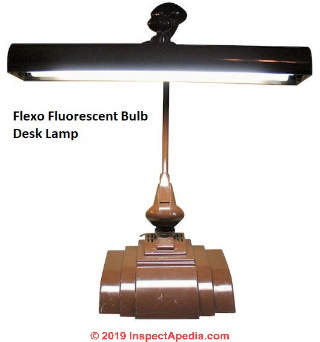 On 2020-01-26 by (mod) - How to re-wire to repairing a fluorescent light desk lamp - Convert to LED bulbs
On 2020-01-26 by (mod) - How to re-wire to repairing a fluorescent light desk lamp - Convert to LED bulbs
Thanks for the photos, Scotty.
Beyond the cooked transformers for your desk lamp I see overheated wires all over the place. It's possible that a wire shorted and that cooked the transformers.
If you really want to salvage this light my first choice would be to pull out all of the parts and wires, toss them, and re-wire the lamp for LED bulbs - simpler, much less costly to run, draws far less current (or uses less watts per hour) , even longer bulb life, no flickering, possibly brighter.
When shopping for LED bulbs for fluorescent lamps take care which sort you buy. Some are "plug-and-play" bulbs that don't require any re-wiring but do require a traditional ballast be left in place. Since your lamp parts are all cooked you don't want this option.
A 110-120V F14T8 LED Tube Light-15"-Warm White 3000K bulb looks like the fluorescent bulbs it replaces, plugs into the same bulb socket, but is used WITHOUT the traditional ballast.
When converting to LED, using the original bulb sockets, you will see that each bulb socket will have two wires that are the same color. REmove all 4 of the wires at the socket. On the converted lamp one pin on the socket on one end of the bulb gets the line or "hot" wire and one pin on the socket for the other end of the bulb gets the "neutral" wire.
Watch out: The bulb manufacturer may specify that one particular (marked AC LINE or AC INPUT or similar) end of the LED bulb must connect to the AC HOT or Line side.
There will of course be more wiring details and drawings provided by the LED-Fluorescent bulb replacement manufacturer.
Watch out: if you're not trained on safe electrical wiring get some help from a pro - you could else be shocked or killed or could start a fire.
Below: an LED replacement for a traditional T-8 Fluorescent lamp or bulb, this one from Premier Lighting.
On 2020-01-26 by scottygm1959
Thank for getting back to me. It seems that the transformers (2) have completely fried, It was working well just a couple days ago, UNTIL, one of the bulbs flashed then went out.
I unplugged the lamp and laid it aside, thinking I could replace the ballast this week, When I unscrewed the base, (see picts) this is what I found,, both of the transformers are little crispy critters,
Any further direction you could give me would be great, I want to restore this lamp to a working condition, I live in the US and have a operating current of 120V the transformer (ballast)? is housed in the base of the lamp.
The wiring seems pretty streight forward.
Will I need 2 ballasts? Thanks
On 2020-01-26 by (mod) - Typically a fluorescent desk lamp is about a 15-22-watt device, depending on your country, operating at 120VAC or 220VAC.
Scotty
Thanks for an interesting question. Typically a fluorescent desk lamp is about a 15-22-watt device, depending on your country, operating at 120VAC or 220VAC.
Because the ballast needs to fit into the lamp, probably in the lamp base, it would make the most sense to flip the lamp over, open the base, and photograph the present ballast - then from the ballast label or imprint or stamping we can see its exact specifications, wiring diagram, and we can also see its dimensions. Otherwise you could buy a generic ballast but it may not fit into the lamp.
An example of a typical fluorescent table lamp ballast is the Philips electronic ballasts Table lamp ballasts SBG1X22W/PLN1 is shown below.
Incidentally you might consider converting the lamp from fluorescent to LED - probably more expensive than replacing the ballast but that's an option.
The number of fluorescent bulbs you need - if you elect that repair approach for your desk lamp, depends on the ballast selected. Some ballasts can power two or even four bulbs.
The number of bulbs supported by a fluorescent lamp ballast are given on a label or imprint right on the ballast as well as in the installation instructions.
On 2020-01-26 by scottygm1959 - a flexo florescent desk lamp from the '50s and need to replace the transformers, (2), What kind
I have a flexo florescent desk lamp from the '50s and need to replace the transformers, (2), What kind do I need? Thanks!
See the photo now above at the conclusion to this discussion
This Q&A were posted originally
at FLUORESCENT LIGHT TRANSFORMER / BALLAST TYPES
On 2019-10-31 by (mod) - 9WPLV/LED/840/DR/4P which requires a ballast with another LED that does not require a ballast?
Re-posting from private email:
Can we replace a
9WPLV/LED/840/DR/4P which requires a ballast with another LED that does not require a ballast? - Anonymous by private email 2019/10/22
Moderator reply:
I've done that successfully in cases where there was a whole string of fluorescent lights in a building, wired in series, operated from a single switch; each light fixture had its own starter and ballast; it was quite possible to replace individual fixtures in that chain without affecting its neighbours.
On 2019-10-22 by Bob electronic ballast for three 30w or 40w rapid start lamps
Looking for a electronic ballast for three 30w or 40w rapid start lamps
On 2019-10-21 by (mod) - T8 fixtures connected together i
I've done what you've described with no problem, assuming I understand your situation correctly.
That is if each light fixture has its own ballast you can change one ballast serving one light fixture without affecting the others.
On 2019-10-20 by Jane F
We have 4 T8 fixtures that are connected together in our kitchen. One of the fixtures burned out and needs to be replaced. Is it safe to put in a newer electronic ballast fluorescent fixture in with 3 older magnetic ballast fixtures. They are all wired together and operate from one wall switch.
...
Continue reading at FLUORESCENT LIGHT TRANSFORMER / BALLAST TYPES or select a topic from the closely-related articles below, or see the complete ARTICLE INDEX.
Or see these
Recommended Articles
- DIAGNOSE a BAD FLUORESCENT LAMP / BULB
- ELECTRIC POWER LOSS / FLICKERING LIGHTS
- FLUORESCENT LIGHTING GUIDE INDOORS for Indoors and Guide to Using Compact Fluorescent Lights
- FLUORESCENT LIGHTS COMPACT INDOOR
- FLUORESCENT LIGHT REPAIRS
- HOW FLUORESCENT LIGHTS WORK
- ELECTRIC POWER LOSS / FLICKERING LIGHTS
- DIAGNOSE a BAD FLUORESCENT LAMP / BULB
- LED BULB REPLACES FLUORESCENT
- REPLACE a FLUORESCENT LAMP / BULB
- FLUORESCENT LIGHT BALLAST TYPES
- FLUORESCENT LIGHT BULB CODES & TYPES
- FLUORESCENT LIGHT BULB PHOTOS
- FLUORESCENT LIGHT BULB COLOR TEMPERATURE
- FLUORESCENT LIGHT FLICKERING CAUSES
- FLUORESCENT LIGHT STARTER REPLACEMENT
- FLUORESCENT LIGHT TRANSFORMER / BALLAST REPLACEMENT
- FLUORESCENT LIGHT TRANSFORMER / BALLAST TYPES
- FLUORESENT BULB SOCKET TYPES
- FLUORESCENT LAMP CONNECTOR / SOCKET REPLACEMENT
- FLUORESCENT LIGHT FIXTURE BULB / BALLAST DISPOSAL
- FLUORESCENT LAMP INSTRUCTIONS, PARTS, REPLACEMENTS
- FLUORESCENT vs INCANDESCENT BULBS
Suggested citation for this web page
FLUORESCENT LIGHT TRANSFORMER / BALLAST REPLACEMENT at InspectApedia.com - online encyclopedia of building & environmental inspection, testing, diagnosis, repair, & problem prevention advice.
Or see this
INDEX to RELATED ARTICLES: ARTICLE INDEX to ELECTRICAL INSPECTION & TESTING
Or use the SEARCH BOX found below to Ask a Question or Search InspectApedia
Ask a Question or Search InspectApedia
Try the search box just below, or if you prefer, post a question or comment in the Comments box below and we will respond promptly.
Search the InspectApedia website
Note: appearance of your Comment below may be delayed: if your comment contains an image, photograph, web link, or text that looks to the software as if it might be a web link, your posting will appear after it has been approved by a moderator. Apologies for the delay.
Only one image can be added per comment but you can post as many comments, and therefore images, as you like.
You will not receive a notification when a response to your question has been posted.
Please bookmark this page to make it easy for you to check back for our response.
IF above you see "Comment Form is loading comments..." then COMMENT BOX - countable.ca / bawkbox.com IS NOT WORKING.
In any case you are welcome to send an email directly to us at InspectApedia.com at editor@inspectApedia.com
We'll reply to you directly. Please help us help you by noting, in your email, the URL of the InspectApedia page where you wanted to comment.
Citations & References
In addition to any citations in the article above, a full list is available on request.
- Our recommended books about building & mechanical systems design, inspection, problem diagnosis, and repair, and about indoor environment and IAQ testing, diagnosis, and cleanup are at the InspectAPedia Bookstore. Also see our Book Reviews - InspectAPedia.
- In addition to citations & references found in this article, see the research citations given at the end of the related articles found at our suggested
CONTINUE READING or RECOMMENDED ARTICLES.
- Carson, Dunlop & Associates Ltd., 120 Carlton Street Suite 407, Toronto ON M5A 4K2. Tel: (416) 964-9415 1-800-268-7070 Email: info@carsondunlop.com. Alan Carson is a past president of ASHI, the American Society of Home Inspectors.
Thanks to Alan Carson and Bob Dunlop, for permission for InspectAPedia to use text excerpts from The HOME REFERENCE BOOK - the Encyclopedia of Homes and to use illustrations from The ILLUSTRATED HOME .
Carson Dunlop Associates provides extensive home inspection education and report writing material. In gratitude we provide links to tsome Carson Dunlop Associates products and services.



